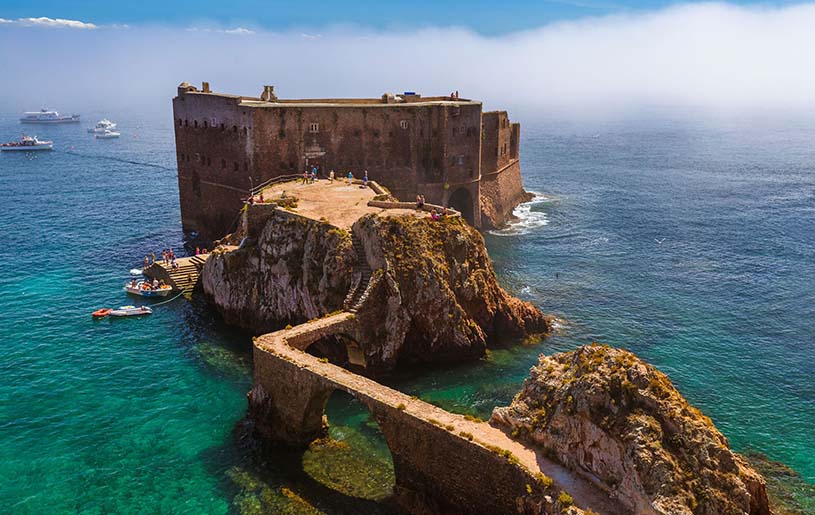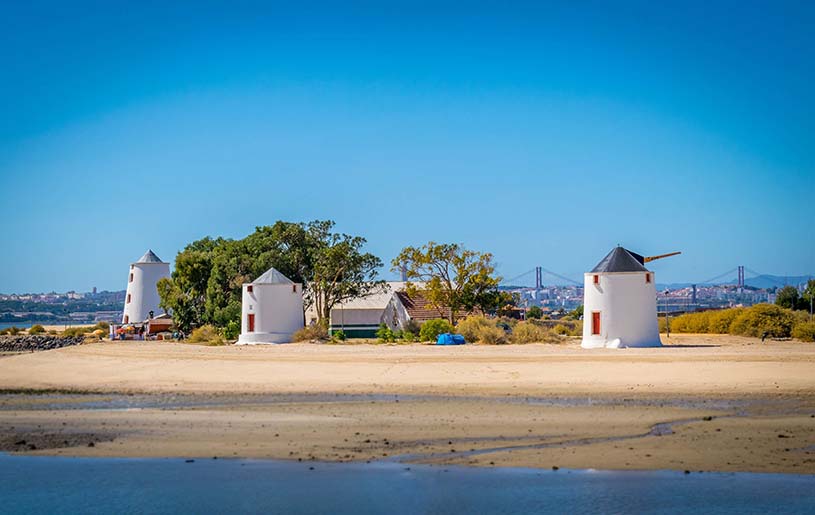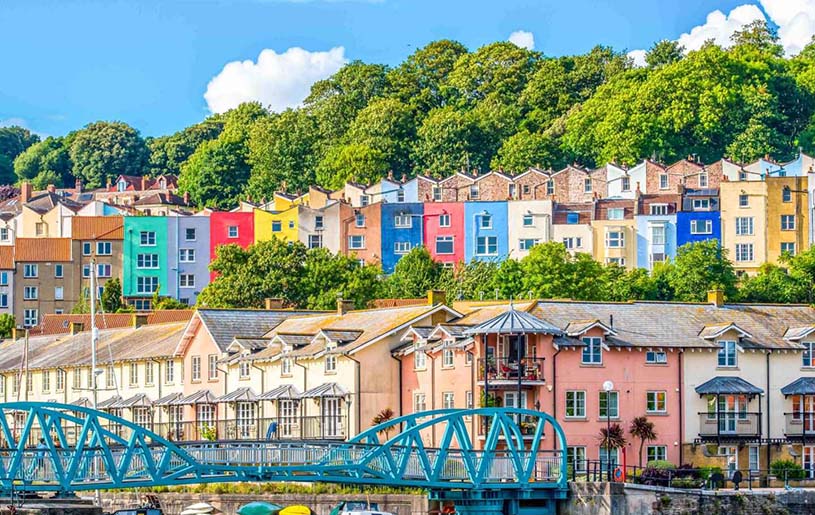Lisbon, the vibrant capital of Portugal, is not only a city brimming with history and culture but also an excellent base for exploring some enchanting nearby destinations. Whether you’re interested in medieval castles, coastal towns, or charming villages, there’s something for everyone within a short distance from Lisbon. Thanks to the travel advice and route planning provided by trivago.co.uk, our journey can be both smooth and enjoyable.
1. Sintra
Sintra is often hailed as one of the most beautiful towns in Portugal, famous for its fairytale palaces and enchanting natural landscapes. The town is steeped in history and romantic architecture, making it a must-visit destination.
How to Get to Sintra from Lisbon
Traveling from Lisbon to Sintra is quite straightforward:
- By Train: You can catch a direct train from Lisbon’s Rossio Station to Sintra. Trains run every 30 minutes, with a journey time of about 40 minutes and a ticket price of around €2.25.
- By Car: For those who prefer the flexibility of driving, renting a car and heading to Sintra is a great option. Simply follow the A37 motorway, which takes approximately 30 minutes.
Must-See Attractions in Sintra
Pena Palace (Palácio da Pena)
Overview
Perched atop the verdant Sintra mountains, the Pena Palace is one of Portugal’s most iconic landmarks. This colorful and eclectic palace stands out with its distinctive blend of architectural styles, including Romanticism, Gothic Revival, Manueline, and Moorish Revival. It was built in the 19th century by Ferdinand II, who transformed a former monastery into this fairy-tale palace. The palace is a UNESCO World Heritage Site and offers an enchanting experience for visitors.
Architectural Features
- Exterior: The exterior of Pena Palace is renowned for its vibrant color scheme, which includes bright yellows, reds, and blues. The palace’s whimsical turrets, intricate tilework, and ornate façades reflect Ferdinand II’s love for Romantic architecture and his fascination with medieval and exotic styles.
- Interior: Inside, the palace boasts richly decorated rooms, including the magnificent Great Hall with its intricate woodwork and the elegant Arab Room featuring Moorish-style arches and tilework. The interior is a mix of opulent rooms and cozy, intimate spaces, all adorned with period furnishings and decorative arts.
Views and Gardens
- Views: From the palace’s vantage point, visitors can enjoy panoramic views of the surrounding Sintra mountains and the lush landscapes stretching to the Atlantic Ocean. The castle’s terraces and viewing platforms offer particularly stunning vistas, especially during clear days when the city of Lisbon can be seen in the distance.
- Gardens: The palace is surrounded by an extensive park with beautifully landscaped gardens, exotic plants, and serene lakes. The gardens are designed in the Romantic style, featuring hidden groves, meandering paths, and delightful garden pavilions.
Visiting Tips
- Best Time to Visit: To avoid crowds and fully appreciate the palace’s beauty, consider visiting early in the morning or late in the afternoon. Spring and autumn are particularly pleasant times to visit, as the weather is mild and the gardens are in full bloom.
- Tickets: It is recommended to purchase tickets in advance to avoid long queues. Tickets can be bought online or at the entrance, but availability may vary during peak tourist seasons.
Moorish Castle (Castelo dos Mouros)
Overview
The Moorish Castle, also known as Castelo dos Mouros, is a medieval fortress located on a hilltop overlooking Sintra. Constructed in the 8th century by the Moors, this castle played a strategic role in the defense of the region during the Reconquista. Its dramatic ruins and commanding position make it a must-visit for history enthusiasts and those seeking spectacular views.
Architectural Features
- Walls and Towers: The castle is renowned for its imposing stone walls and watchtowers, which stretch along the ridge of the hill. The walls are partially restored, allowing visitors to walk along the ramparts and experience the same defensive positions once occupied by soldiers.
- Gatehouse: The castle’s main entrance features a picturesque gatehouse, which is an excellent example of Moorish military architecture. The gatehouse provides a dramatic entry to the castle grounds and offers excellent photo opportunities.
Views and Historical Context
- Views: The castle’s elevated position offers breathtaking panoramic views of the Sintra mountains, the town of Sintra, and the Atlantic Ocean. From the highest points of the castle, visitors can see the distant outline of the Pena Palace and enjoy unobstructed views of the surrounding natural beauty.
- Historical Context: The Moorish Castle played a crucial role in the defense of the region against Christian forces during the Reconquista. After the Portuguese captured Sintra in the 12th century, the castle fell into disrepair but has since been partially restored for visitors.
Visiting Tips
- Best Time to Visit: The castle can be quite crowded during peak tourist seasons, so visiting early in the day or later in the afternoon is advisable. The cooler months of spring and autumn offer a more comfortable experience.
- Wear Comfortable Shoes: The castle’s terrain is uneven, with steep paths and staircases. Comfortable, sturdy footwear is recommended for exploring the site.
Quinta da Regaleira
Overview
Quinta da Regaleira is a historic estate situated on the slopes of Sintra’s hills. Built in the early 20th century by wealthy Brazilian merchant Carvalho Monteiro, the estate is renowned for its enigmatic architecture, lush gardens, and intricate symbolism. The estate is a UNESCO World Heritage Site and offers a fascinating glimpse into the mystical and esoteric interests of its creator.
Architectural Features
- Palace: The central building of Quinta da Regaleira is a grand mansion with ornate Gothic Revival architecture. The palace features turrets, balconies, and elaborate stone carvings that reflect a blend of medieval and Renaissance styles.
- Underground Tunnels: One of the estate’s most intriguing features is its network of underground tunnels. These tunnels connect various parts of the estate, including the Initiation Well, a mysterious spiral staircase that descends deep underground and is believed to have been used for ritual purposes.
Gardens and Symbolism
- Gardens: The estate’s gardens are a masterpiece of landscape design, featuring lush vegetation, artificial lakes, and whimsical structures such as the well-known “Cenote” or “Initiation Well.” The gardens are designed with symbolic elements, including mystical symbols and hidden pathways that invite exploration.
- Symbolism: Quinta da Regaleira is rich in esoteric and mystical symbolism, with elements related to alchemy, Freemasonry, and the occult scattered throughout the estate. The design reflects Carvalho Monteiro’s interest in these themes, with symbolic references embedded in the architecture and landscaping.
Visiting Tips
- Best Time to Visit: The estate is less crowded during the off-peak seasons of spring and autumn. To fully appreciate the intricate details and peaceful atmosphere, visiting during weekdays is recommended.
- Guided Tours: Consider taking a guided tour to gain deeper insights into the symbolism and history of the estate. Many tours provide fascinating background information that enhances the overall experience.
Sintra’s Pena Palace, Moorish Castle, and Quinta da Regaleira each offer unique experiences that reflect the rich history and cultural heritage of the region. From the fairytale charm of Pena Palace to the historical significance of the Moorish Castle and the mystical allure of Quinta da Regaleira, these landmarks provide a captivating glimpse into Sintra’s past and present. Exploring these sites offers a memorable journey through the enchanting landscapes and architectural wonders of one of Portugal’s most picturesque towns.

2. Peniche
Peniche is a charming fishing town renowned for its stunning coastline and beautiful beaches. It’s also a paradise for surfing enthusiasts.
How to Get to Peniche from Lisbon
You have several options to reach Peniche:
- By Bus: Take a bus from Lisbon’s Sete Rios station directly to Peniche. The journey takes approximately 1.5 hours, with a ticket price around €8.
- By Car: For those who prefer to drive, taking the A8 and IP6 motorways will get you to Peniche in about 1 hour and 20 minutes.
Must-See Attractions in Peniche
- Fortaleza de Peniche: This historic fortress is a significant cultural landmark that offers insights into Peniche’s maritime history.
- Supertubos Beach: Known for its world-class surf breaks, this beach attracts surfers from around the globe each year.
- Berlenga Islands: A short boat trip from Peniche will take you to these beautiful islands, where you can enjoy stunning natural landscapes and rich marine life.
3. Évora
Évora is a gem of the Alentejo region, celebrated for its well-preserved medieval architecture and rich historical heritage. As a UNESCO World Heritage site, Évora offers a deep dive into Portugal’s history and culture.
How to Get to Évora from Lisbon
There are a few convenient ways to reach Évora:
- By Train: Direct trains depart from Lisbon’s Oriente Station to Évora. The journey takes about 1.5 hours, and tickets cost around €12.
- By Bus: Buses from Sete Rios station to Évora also take approximately 1.5 hours, with tickets priced around €12.
- By Car: Driving along the A6 motorway will get you to Évora in roughly 1.5 hours.
Must-See Attractions in Évora
- Roman Temple (Templo Romano): This ancient Roman ruin is one of Évora’s most iconic landmarks.
- Church of São Francisco and the Chapel of Bones (Capela dos Ossos): The unique design and historical significance of this church and its eerie chapel make it a fascinating visit.
- University of Évora (Universidade de Évora): One of Portugal’s oldest universities, its historic buildings and beautiful campus are worth exploring.
4. Óbidos
Óbidos is a picturesque medieval town renowned for its well-preserved walls and narrow cobblestone streets. The town often hosts cultural events and festivals, offering a glimpse into traditional Portuguese life.
How to Get to Óbidos from Lisbon
To reach Óbidos, consider the following options:
- By Bus: Buses from Lisbon’s Campo Grande station to Óbidos take about 1 hour, with a ticket price around €7.5.
- By Car: Driving along the A8 motorway will get you to Óbidos in approximately 1 hour.
Must-See Attractions in Óbidos
- Óbidos Castle (Castelo de Óbidos): This medieval castle is a highlight of the town and offers panoramic views of the surrounding area.
- Santa Maria Church (Igreja de Santa Maria): This church, known for its beautiful azulejos (Portuguese tiles) and historical significance, is a must-see.
- Chocolate Festival and Medieval Fair: Óbidos hosts various festivals throughout the year, including the Chocolate Festival and Medieval Fair, which are popular with both locals and tourists.
5. Barreiro

Barreiro, located on the southern bank of the Tagus River, is a city with a rich industrial and cultural history. It offers beautiful natural landscapes and numerous historical sites.
How to Get to Barreiro from Lisbon
To travel to Barreiro, you can use the following options:
- By Ferry: Take a ferry from Lisbon’s Cais do Sodré terminal to Barreiro. The trip takes around 20 minutes and costs approximately €2.5.
- By Train: Trains from Lisbon’s Oriente Station to Barreiro take about 30 minutes, with tickets priced around €3.
Must-See Attractions in Barreiro
- Barreiro Museum (Museu Industrial Baía do Tejo): This museum showcases Barreiro’s industrial history and cultural heritage.
- Church of Our Lady of Good Success (Igreja de Nossa Senhora do Bom Sucesso): This church is a religious and cultural center with impressive architecture.
- Barreiro Park (Parque da Cidade): A great spot for relaxation, featuring beautiful gardens and serene lakes.
6. Cacilhas
Cacilhas is a charming town on the southern bank of Lisbon’s Tagus River, known for its scenic river views and relaxed atmosphere. It’s a perfect place to enjoy local cuisine and culture.
How to Get to Cacilhas from Lisbon
Traveling to Cacilhas is easy with these options:
- By Ferry: Take a ferry from Lisbon’s Cais do Sodré terminal to Cacilhas. The trip takes about 10 minutes and costs around €1.2.
- By Bus: Buses from central Lisbon to Cacilhas take approximately 20 minutes, with a ticket price around €2.
Must-See Attractions in Cacilhas
- Church of Our Lady of Good Success (Igreja de Nossa Senhora do Bom Sucesso): This church features beautiful architecture and a long history.
- Almada Forum: This monument provides stunning views of Lisbon and the Tagus River.
- Traditional Restaurants and Bars: Cacilhas is home to numerous traditional restaurants and bars, making it a great place to sample local dishes and experience the local culture.
Exploring these day trip destinations from Lisbon offers a chance to experience the diverse beauty and culture of Portugal. From the fairy-tale palaces of Sintra to the picturesque streets of Óbidos, there’s something for everyone. A special thanks to trivago.co.uk for providing the detailed travel advice and route planning that makes these adventures possible. Whether you’re a history buff, nature enthusiast, or food lover, these destinations will provide unforgettable experiences and add a rich layer to your Portuguese journey. I hope this guide helps you plan the perfect day trips from Lisbon and enjoy all that these wonderful places have to offer.






